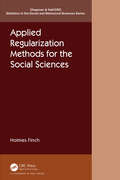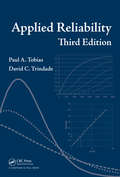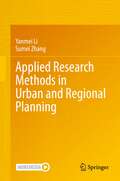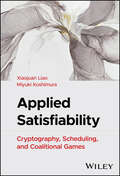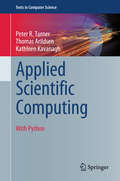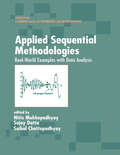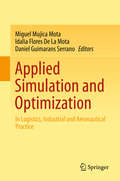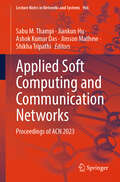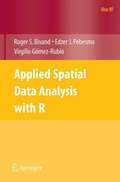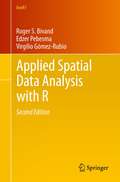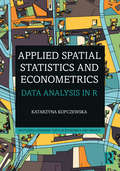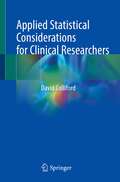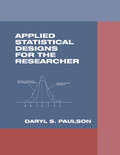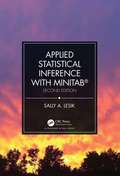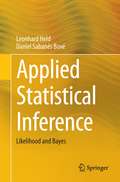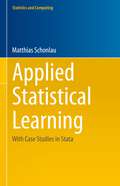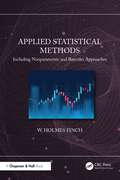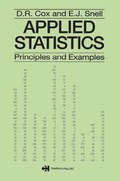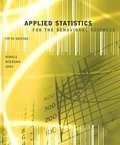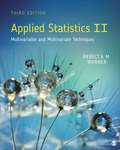- Table View
- List View
Applied Regularization Methods for the Social Sciences (Chapman & Hall/CRC Statistics in the Social and Behavioral Sciences)
by Holmes FinchResearchers in the social sciences are faced with complex data sets in which they have relatively small samples and many variables (high dimensional data). Unlike the various technical guides currently on the market, Applied Regularization Methods for the Social Sciences provides and overview of a variety of models alongside clear examples of hands-on application. Each chapter in this book covers a specific application of regularization techniques with a user-friendly technical description, followed by examples that provide a thorough demonstration of the methods in action. Key Features: Description of regularization methods in a user friendly and easy to read manner Inclusion of regularization-based approaches for a variety of statistical analyses commonly used in the social sciences, including both univariate and multivariate models Fully developed extended examples using multiple software packages, including R, SAS, and SPSS Website containing all datasets and software scripts used in the examples Inclusion of both frequentist and Bayesian regularization approaches Application exercises for each chapter that instructors could use in class, and independent researchers could use to practice what they have learned from the book
Applied Reliability
by Paul A. Tobias David TrindadeSince the publication of the second edition of Applied Reliability in 1995, the ready availability of inexpensive, powerful statistical software has changed the way statisticians and engineers look at and analyze all kinds of data. Problems in reliability that were once difficult and time consuming even for experts can now be solved with a few well
Applied Research Methods in Urban and Regional Planning
by Yanmei Li Sumei ZhangThis book introduces the fundamentals of research methods and how they apply to the discipline of urban and regional planning. Written at a level appropriate for upper-level undergraduate and beginning master’s level students, the text fills a gap in the literature for textbooks on urban planning. Additionally, the book can be used as a reference for planning practitioners and researchers when analyzing quantitative and qualitative data in urban and regional planning and related fields.The volume does not assume advanced knowledge of mathematical formulas. Rather, it begins with the essentials of research methods, such as the identification of the research problems in planning, the literature review, data collection and presentation, descriptive data analysis, and report of findings. Its discipline-specific topics include field research methods, qualitative data analysis, economic and demographic analysis, evaluation research, and methods in sub-disciplines such as land use planning, transportation planning, environmental planning, and housing analysis. Designed with instruction in mind, this book features downloadable materials, including learning outcomes, chapter highlights, chapter review questions, datasets, and certain Excel models. Students will be able to download review questions to enhance the learning process and datasets to practice methods.
Applied Satisfiability: Cryptography, Scheduling, and Coalitional Games
by Xiaojuan Liao Miyuki KoshimuraApply satisfiability to a range of difficult problems The Boolean Satisfiability Problem (SAT) is one of the most famous and widely-studied problems in Boolean logic. Optimization versions of this problem include the Maximum Satisfiability Problem (MaxSAT) and its extensions, such as partial MaxSAT and weighted MaxSAT, which assess whether, and to what extent, a solution satisfies a given set of problems. Numerous applications of SAT and MaxSAT have emerged in fields related to logic and computing technology. Applied Satisfiability: Cryptography, Scheduling, and Coalitional Games outlines some of these applications in three specific fields. It offers a huge range of SAT applications and their possible impacts, allowing readers to tackle previously challenging optimization problems with a new selection of tools. Professionals and researchers in this field will find the scope of their computational solutions to otherwise intractable problems vastly increased. Applied Satisfiability readers will also find: Coding and problem-solving skills applicable to a variety of fieldsSpecific experiments and case studies that demonstrate the effectiveness of satisfiability-aided methodsChapters covering topics including cryptographic key recovery, various forms of scheduling, coalition structure generation, and many more Applied Satisfiability is ideal for researchers, graduate students, and practitioners in these fields looking to bring a new skillset to bear in their studies and careers.
Applied Scientific Computing: With Python (Texts in Computer Science)
by Peter R. Turner Thomas Arildsen Kathleen KavanaghThis easy-to-understand textbook presents a modern approach to learning numerical methods (or scientific computing), with a unique focus on the modeling and applications of the mathematical content. Emphasis is placed on the need for, and methods of, scientific computing for a range of different types of problems, supplying the evidence and justification to motivate the reader. Practical guidance on coding the methods is also provided, through simple-to-follow examples using Python.Topics and features: provides an accessible and applications-oriented approach, supported by working Python code for many of the methods; encourages both problem- and project-based learning through extensive examples, exercises, and projects drawn from practical applications; introduces the main concepts in modeling, python programming, number representation, and errors; explains the essential details of numerical calculus, linear, and nonlinear equations, including the multivariable Newton method; discusses interpolation and the numerical solution of differential equations, covering polynomial interpolation, splines, and the Euler, Runge–Kutta, and shooting methods; presents largely self-contained chapters, arranged in a logical order suitable for an introductory course on scientific computing.Undergraduate students embarking on a first course on numerical methods or scientific computing will find this textbook to be an invaluable guide to the field, and to the application of these methods across such varied disciplines as computer science, engineering, mathematics, economics, the physical sciences, and social science.
Applied Sequential Methodologies: Real-World Examples with Data Analysis
by Hitis Mukhopadhyay Suiay Datta Saibal ChattopadhyayA technically precise yet clear presentation of modern sequential methodologies having immediate applications to practical problems in the real world, Applied Sequential Methodologies communicates invaluable techniques for data mining, agricultural science, genetics, computer simulation, finance, clinical trials, sonar signal detection, randomizati
Applied Simulation and Optimization: In Logistics, Industrial and Aeronautical Practice
by Miguel Mujica Mota Idalia Flores De La Mota Daniel Guimarans SerranoPresenting techniques, case-studies and methodologies that combine the use of simulation approaches with optimization techniques for facing problems in manufacturing, logistics, or aeronautical problems, this book provides solutions to common industrial problems in several fields, which range from manufacturing to aviation problems, where the common denominator is the combination of simulation's flexibility with optimization techniques' robustness. Providing readers with a comprehensive guide to tackle similar issues in industrial environments, this text explores novel ways to face industrial problems through hybrid approaches (simulation-optimization) that benefit from the advantages of both paradigms, in order to give solutions to important problems in service industry, production processes, or supply chains, such as scheduling, routing problems and resource allocations, among others.
Applied Soft Computing and Communication Networks: Proceedings of ACN 2023 (Lecture Notes in Networks and Systems #966)
by Jimson Mathew Sabu M. Thampi Jiankun Hu Ashok Kumar Das Shikha TripathiThis book constitutes thoroughly refereed post-conference proceedings of the International Applied Soft Computing and Communication Networks (ACN 2023) held at PES University, Bangalore, India, during December 18–20, 2023. The research papers presented were carefully reviewed and selected from several initial submissions. The papers are organized in topical sections on security and privacy, network management and software-defined networks, Internet of Things (IoT) and cyber-physical systems, intelligent distributed systems, mobile computing and vehicle communications, and emerging topics. The book is directed to the researchers and scientists engaged in various fields of intelligent systems.
Applied Spatial Data Analysis with R
by Roger Bivand Edzer J. Pebesma Virgilio Gómez-Rubio Roger S. BivandApplied Spatial Data Analysis with R is divided into two basic parts, the first presenting R packages, functions, classes and methods for handling spatial data. This part is of interest to users who need to access and visualise spatial data. Data import and export for many file formats for spatial data are covered in detail, as is the interface between R and the open source GRASS GIS. The second part showcases more specialised kinds of spatial data analysis, including spatial point pattern analysis, interpolation and geostatistics, areal data analysis and disease mapping. The coverage of methods of spatial data analysis ranges from standard techniques to new developments, and the examples used are largely taken from the spatial statistics literature. All the examples can be run using R contributed packages available from the CRAN website, with code and additional data sets from the book's own website. This book will be of interest to researchers who intend to use R to handle, visualise, and analyse spatial data. It will also be of interest to spatial data analysts who do not use R, but who are interested in practical aspects of implementing software for spatial data analysis. It is a suitable companion book for introductory spatial statistics courses and for applied methods courses in a wide range of subjects using spatial data, including human and physical geography, geographical information systems, the environmental sciences, ecology, public health and disease control, economics, public administration and political science.
Applied Spatial Data Analysis with R (Use R! #10)
by Virgilio Gómez-Rubio Roger S. Bivand Edzer PebesmaApplied Spatial Data Analysis with R, second edition, is divided into two basic parts, the first presenting R packages, functions, classes and methods for handling spatial data. This part is of interest to users who need to access and visualise spatial data. Data import and export for many file formats for spatial data are covered in detail, as is the interface between R and the open source GRASS GIS and the handling of spatio-temporal data. The second part showcases more specialised kinds of spatial data analysis, including spatial point pattern analysis, interpolation and geostatistics, areal data analysis and disease mapping. The coverage of methods of spatial data analysis ranges from standard techniques to new developments, and the examples used are largely taken from the spatial statistics literature. All the examples can be run using R contributed packages available from the CRAN website, with code and additional data sets from the book's own website. Compared to the first edition, the second edition covers the more systematic approach towards handling spatial data in R, as well as a number of important and widely used CRAN packages that have appeared since the first edition. This book will be of interest to researchers who intend to use R to handle, visualise, and analyse spatial data. It will also be of interest to spatial data analysts who do not use R, but who are interested in practical aspects of implementing software for spatial data analysis. It is a suitable companion book for introductory spatial statistics courses and for applied methods courses in a wide range of subjects using spatial data, including human and physical geography, geographical information science and geoinformatics, the environmental sciences, ecology, public health and disease control, economics, public administration and political science. The book has a website where complete code examples, data sets, and other support material may be found: http://www.asdar-book.org. The authors have taken part in writing and maintaining software for spatial data handling and analysis with R in concert since 2003.
Applied Spatial Statistics and Econometrics: Data Analysis in R (Routledge Advanced Texts in Economics and Finance)
by Katarzyna KopczewskaThis textbook is a comprehensive introduction to applied spatial data analysis using R. Each chapter walks the reader through a different method, explaining how to interpret the results and what conclusions can be drawn. The author team showcases key topics, including unsupervised learning, causal inference, spatial weight matrices, spatial econometrics, heterogeneity and bootstrapping. It is accompanied by a suite of data and R code on Github to help readers practise techniques via replication and exercises. This text will be a valuable resource for advanced students of econometrics, spatial planning and regional science. It will also be suitable for researchers and data scientists working with spatial data.
Applied Statistical Considerations for Clinical Researchers
by David CullifordThis essential book details intermediate-level statistical methods and frameworks for the clinician and medical researcher with an elementary grasp of health statistics and focuses on selecting the appropriate statistical method for many scenarios. Detailed evaluation of various methodologies familiarizes readers with the available techniques and equips them with the tools to select the best from a range of options. The inclusion of a hypothetical case study between a clinician and statistician charting the conception of the research idea through to results dissemination enables the reader to understand how to apply the concepts covered into their day-to-day clinical practice.Applied Statistical Considerations for Clinical Researchers focuses on how clinicians can approach statistical issues when confronted with a medical research problem by considering the data structure, how this relates to their study's aims and any potential knock-on effects relating to the evidence required to make correct clinical decisions. It covers the application of intermediate-level techniques in health statistics making it an ideal resource for the clinician seeking an up-to-date resource on the topic.
Applied Statistical Designs for the Researcher (Chapman & Hall/CRC Biostatistics Series)
by Daryl S. PaulsonShowcasing a discussion of the experimental process and a review of basic statistics, this volume provides methodologies to identify general data distribution, skewness, and outliers. It features a unique classification of the nonparametric analogs of their parametric counterparts according to the strength of the collected data. Applied Statistical Designs for the Researcher discusses three varieties of the Student t test, including a comparison of two different groups with different variances; two groups with the same variance; and a matched, paired group. It introduces the analysis of variance and Latin Square designs and presents screening approaches to comparing two factors and their interactions.
Applied Statistical Inference with MINITAB®, Second Edition
by Sally A. LesikPraise for the first edition: "One of my biggest complaints when I teach introductory statistics classes is that it takes me most of the semester to get to the good stuff—inferential statistics. The author manages to do this very quickly….if one were looking for a book that efficiently covers basic statistical methodology and also introduces statistical software [this text] fits the bill." -The American Statistician Applied Statistical Inference with MINITAB, Second Edition distinguishes itself from other introductory statistics textbooks by focusing on the applications of statistics without compromising mathematical rigor. It presents the material in a seamless step-by-step approach so that readers are first introduced to a topic, given the details of the underlying mathematical foundations along with a detailed description of how to interpret the findings, and are shown how to use the statistical software program Minitab to perform the same analysis. Gives readers a solid foundation in how to apply many different statistical methods. MINITAB is fully integrated throughout the text. Includes fully worked out examples so students can easily follow the calculations. Presents many new topics such as one- and two-sample variances, one- and two-sample Poisson rates, and more nonparametric statistics. Features mostly new exercises as well as the addition of Best Practices sections that describe some common pitfalls and provide some practical advice on statistical inference. This book is written to be user-friendly for students and practitioners who are not experts in statistics, but who want to gain a solid understanding of basic statistical inference. This book is oriented towards the practical use of statistics. The examples, discussions, and exercises are based on data and scenarios that are common to students in their everyday lives.
Applied Statistical Inference: Likelihood and Bayes
by Leonhard Held Daniel Sabanés BovéThis book covers modern statistical inference based on likelihood with applications in medicine, epidemiology and biology. Two introductory chapters discuss the importance of statistical models in applied quantitative research and the central role of the likelihood function. The rest of the book is divided into three parts. The first describes likelihood-based inference from a frequentist viewpoint. Properties of the maximum likelihood estimate, the score function, the likelihood ratio and the Wald statistic are discussed in detail. In the second part, likelihood is combined with prior information to perform Bayesian inference. Topics include Bayesian updating, conjugate and reference priors, Bayesian point and interval estimates, Bayesian asymptotics and empirical Bayes methods. Modern numerical techniques for Bayesian inference are described in a separate chapter. Finally two more advanced topics, model choice and prediction, are discussed both from a frequentist and a Bayesian perspective. A comprehensive appendix covers the necessary prerequisites in probability theory, matrix algebra, mathematical calculus, and numerical analysis.
Applied Statistical Learning: With Case Studies in Stata (Statistics and Computing)
by Matthias SchonlauThis textbook provides an accessible overview of statistical learning methods and techniques, and includes case studies using the statistical software Stata. After introductory material on statistical learning concepts and practical aspects, each further chapter is devoted to a statistical learning algorithm or a group of related techniques. In particular, the book presents logistic regression, regularized linear models such as the Lasso, nearest neighbors, the Naive Bayes classifier, classification trees, random forests, boosting, support vector machines, feature engineering, neural networks, and stacking. It also explains how to construct n-gram variables from text data. Examples, conceptual exercises and exercises using software are featured throughout, together with case studies in Stata, mostly from the social sciences; true to the book’s goal to facilitate the use of modern methods of data science in the field. Although mainly intended for upper undergraduate and graduate students in the social sciences, given its applied nature, the book will equally appeal to readers from other disciplines, including the health sciences, statistics, engineering and computer science.
Applied Statistical Methods: Including Nonparametric and Bayesian Approaches
by W. Holmes FinchThis book is designed to provide students, teachers, and researchers with a text that includes a full range of statistical methods available to address commonly encountered research problems. Many textbooks for introductory, intermediate, and advanced statistics courses focus heavily on parametric methods. However, in practice, the assumptions underlying these methods are frequently not met, therefore calling into question their use. This book addresses this issue by presenting parametric, nonparametric, robust, and Bayesian techniques that are appropriate for research scenarios often encountered in practice and typically found in statistics courses. For each of these major topics, the standard parametric approach is presented, along with the assumptions underlying it and the methods used to assess the viability of these assumptions. Next, a set of alternative techniques for the research scenario is presented and applied to the motivating example that begins each chapter. Each chapter concludes with a summary focused on how researchers should select which method to use when and a summary of the material covered in the chapter. The chapters have motivating examples that serve as an anchor for discussion of the featured methods. The focus of the chapters is intended to be conceptual (as opposed to highly technical) to make the text useful to individuals with a wide array of statistical backgrounds. More technical material is included in each chapter for interested readers and instructors who would like to focus more attention on it. Instructors will be able to use this book as a main text in introductory, intermediate, and some specialized statistics courses such as nonparametric and robust methods. In addition, researchers and data analysts from a wide array of disciplines will be able to use this book as a primary resource in their work.Key features of this book are as follows: It presents a full range of statistical options available to researchers for major problems faced in the social and life sciences, health care, and business. It explains how to evaluate a dataset to determine which statistical approach (e.g., standard parametric, nonparametric, robust, Bayesian) may be optimal. It features a website containing datasets and computer code.
Applied Statistics - Principles and Examples
by D.R. CoxThis book should be of interest to senior undergraduate and postgraduate students of applied statistics.
Applied Statistics For The Behavioral Sciences
by William Wiersma Stephen G. Jurs Dennis E. HinkleThis introductory text provides students with a conceptual understanding of basic statistical procedures, as well as the computational skills needed to complete them. The clear presentation, accessible language, and step-by-step instruction make it easy for students from a variety of social science disciplines to grasp the material. The scenarios presented in chapter exercises span the curriculum, from political science to marketing, so that students make a connection between their own area of interest and the study of statistics. Unique coverage focuses on concepts critical to understanding current statistical research such as power and sample size, multiple comparison tests, multiple regression, and analysis of covariance. Additional SPSS coverage throughout the text includes computer printouts and expanded discussion of their contents in interpreting the results of sample exercises.
Applied Statistics I: Basic Bivariate Techniques
by Rebecca M. WarnerRebecca M. Warner’s bestselling Applied Statistics: From Bivariate Through Multivariate Techniques has been split into two volumes for ease of use over a two-course sequence. Applied Statistics I: Basic Bivariate Techniques, Third Edition is an introductory statistics text based on chapters from the first half of the original book. The author's contemporary approach reflects current thinking in the field, with its coverage of the "new statistics" and reproducibility in research. Her in-depth presentation of introductory statistics follows a consistent chapter format, includes some simple hand-calculations along with detailed instructions for SPSS, and helps students understand statistics in the context of real-world research through interesting examples. Datasets are provided on an accompanying website.
Applied Statistics I: Basic Bivariate Techniques
by Rebecca M. WarnerRebecca M. Warner&’s bestselling Applied Statistics: From Bivariate Through Multivariate Techniques has been split into two volumes for ease of use over a two-course sequence. Applied Statistics I: Basic Bivariate Techniques, Third Edition is an introductory statistics text based on chapters from the first half of the original book. The author's contemporary approach reflects current thinking in the field, with its coverage of the "new statistics" and reproducibility in research. Her in-depth presentation of introductory statistics follows a consistent chapter format, includes some simple hand-calculations along with detailed instructions for SPSS, and helps students understand statistics in the context of real-world research through interesting examples. Datasets are provided on an accompanying website.
Applied Statistics II: Multivariable and Multivariate Techniques
by Rebecca M. WarnerRebecca M. Warner&’s bestselling Applied Statistics: From Bivariate Through Multivariate Techniques has been split into two volumes for ease of use over a two-course sequence. Applied Statistics II: Multivariable and Multivariate Techniques, Third Edition is a core multivariate statistics text based on chapters from the second half of the original book. The text begins with two new chapters: an introduction to the new statistics, and a chapter on handling outliers and missing values. All chapters on statistical control and multivariable or multivariate analyses from the previous edition are retained (with the moderation chapter heavily revised) and new chapters have been added on structural equation modeling, repeated measures, and on additional statistical techniques. Each chapter includes a complete example, and begins by considering the types of research questions that chapter&’s technique can answer, progresses to data screening, and provides screen shots of SPSS menu selections and output, and concludes with sample results sections. By-hand computation is used, where possible, to show how elements of the output are related to each other, and to obtain confidence interval and effect size information when SPSS does not provide this. Datasets are available on the accompanying website.
Applied Statistics II: Multivariable and Multivariate Techniques
by Rebecca M. WarnerRebecca M. Warner&’s bestselling Applied Statistics: From Bivariate Through Multivariate Techniques has been split into two volumes for ease of use over a two-course sequence. Applied Statistics II: Multivariable and Multivariate Techniques, Third Edition is a core multivariate statistics text based on chapters from the second half of the original book. The text begins with two new chapters: an introduction to the new statistics, and a chapter on handling outliers and missing values. All chapters on statistical control and multivariable or multivariate analyses from the previous edition are retained (with the moderation chapter heavily revised) and new chapters have been added on structural equation modeling, repeated measures, and on additional statistical techniques. Each chapter includes a complete example, and begins by considering the types of research questions that chapter&’s technique can answer, progresses to data screening, and provides screen shots of SPSS menu selections and output, and concludes with sample results sections. By-hand computation is used, where possible, to show how elements of the output are related to each other, and to obtain confidence interval and effect size information when SPSS does not provide this. Datasets are available on the accompanying website.
Applied Statistics Using R: A Guide for the Social Sciences
by Mehmet Mehmetoglu Matthias MittnerIf you want to learn to use R for data analysis but aren’t sure how to get started, this practical book will help you find the right path through your data. Drawing on real-world data to show you how to use different techniques in practice, it helps you progress your programming and statistics knowledge so you can apply the most appropriate tools in your research. It starts with descriptive statistics and moves through regression to advanced techniques such as structural equation modelling and Bayesian statistics, all with digestible mathematical detail for beginner researchers. The book: Shows you how to use R packages and apply functions, adjusting them to suit different datasets. Gives you the tools to try new statistical techniques and empowers you to become confident using them. Encourages you to learn by doing when running and adapting the authors’ own code. Equips you with solutions to overcome the potential challenges of working with real data that may be messy or imperfect. Accompanied by online resources including screencast tutorials of R that give you step by step guidance and R scripts and datasets for you to practice with, this book is a perfect companion for any student of applied statistics or quantitative research methods courses.
Applied Statistics Using R: A Guide for the Social Sciences
by Mehmet Mehmetoglu Matthias MittnerIf you want to learn to use R for data analysis but aren’t sure how to get started, this practical book will help you find the right path through your data. Drawing on real-world data to show you how to use different techniques in practice, it helps you progress your programming and statistics knowledge so you can apply the most appropriate tools in your research. It starts with descriptive statistics and moves through regression to advanced techniques such as structural equation modelling and Bayesian statistics, all with digestible mathematical detail for beginner researchers. The book: Shows you how to use R packages and apply functions, adjusting them to suit different datasets. Gives you the tools to try new statistical techniques and empowers you to become confident using them. Encourages you to learn by doing when running and adapting the authors’ own code. Equips you with solutions to overcome the potential challenges of working with real data that may be messy or imperfect. Accompanied by online resources including screencast tutorials of R that give you step by step guidance and R scripts and datasets for you to practice with, this book is a perfect companion for any student of applied statistics or quantitative research methods courses.
